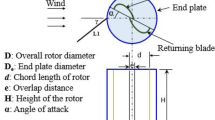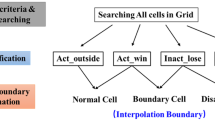Abstract
In the present study, the parametric study was performed to analyze the effect of the tab on the aerodynamic performance and characteristics of rotor blades. Also, the tab shape was designed to improve the aerodynamic performance of rotor blades. A computational fluid dynamics solver based on three-dimensional Reynolds averaged Navier–Stokes equation using an unstructured mesh was used for the parametric study and the tab design. For airfoils, the effect of length and angle of a tab was studied on the aerodynamic characteristics of airfoils. In addition, including those parameters, the effect of a span of a tab was studied for rotor blades in hovering flight. The results of the parametric study were analyzed in terms of change of the aerodynamic performance and characteristics to understand the effect of a tab. Considering the analysis, the design of tab shape was conducted to improve the aerodynamic performance of rotor blades. The simply attached tab to trailing edge of the rotor blades increases the thrust of the rotor blades without significant changing of aerodynamic characteristics of the rotor blades in hovering and forward flight.


























Similar content being viewed by others
Abbreviations
- \(C_\mathrm{l}, C_\mathrm{d}\) :
-
Lift and drag coefficient of an airfoil
- \(C_{m, 1/4}\) :
-
Moment coefficient of an airfoil at 1/4-chord
- \(C_\mathrm{T}, C_\mathrm{P}, C_\mathrm{Q}\) :
-
Thrust, power, and torque coefficient
- F :
-
Convective fluxes
- F.M.:
-
Figure of merit
- \(F_\mathrm{th}, F_\mathrm{tq}, F_\mathrm{D}\) :
-
Sectional thrust, torque, and drag forces, N/m
- G :
-
Diffusive fluxes
- l / c :
-
Ratio of tab length to chord length
- \(M_{y,r}\) :
-
Sectional pitching moment, \(\hbox {N}\times \hbox {m}/\hbox {m}\)
- \(N_{\mathrm{b}}\) :
-
Number of blades
- Q :
-
Conservative variables
- R :
-
Radius of the rotor blade, m
- r / R :
-
Non-dimensional position in radial direction
- S :
-
Source term
- V :
-
Arbitrary control volume
- w / R :
-
Ratio of tab span to blade radius
- \(\delta \) :
-
Deflection angle of tab, deg
- \(\lambda \) :
-
Inflow ratio
- \({\upsigma }\) :
-
Solidity
- \(\phi \) :
-
Relative inflow angle, deg
- \(\partial V\) :
-
Boundary of control volume
References
Leishman JG (2006) Principles of helicopter aerodynamics. Cambridge University Press, New York
Dadone LU (1976) US Army Helicopter Design Datcom, vol 1. Airfoils, NASA-CR-153247
Prouty RW (1989) Helicopter performance, stability, and control. Krieger Publishing Company, Malabar
Prouty RW (1975) A state-of-the-art survey of two-dimensional airfoil data. J Am Helicopter Soc 20(4):14–25. https://doi.org/10.4050/JAHS.20.14
Lizak AA (1960) Two-dimensional wind tunnel tests of an H-34 main rotor airfoil section. Defense Technical Information Center. https://doi.org/10.21236/AD0466300
Davenport FJ, Front JV (1966) Airfoil sections for rotor blades—a reconsideration. In: Proceedings of the American Helicopter Society 22nd annual forum, Washington, D.C
Wiener W, Kohler G (1974) Tail rotor design guide. USAAMRDL-TR-73-99
Kostic I (2007) Numerical evaluation of the aerodynamic influence of the helicopter composite blade trailing edge tabs. Arch Appl Mech 77(12):893–909. https://doi.org/10.1007/S00419-007-0133-1
Ben-Zeev O, Chopra I (1966) Advances in the development of an intelligent helicopter rotor employing smart trailing-edge flaps. Smart Mater Struct 5(1):11–25. https://doi.org/10.1088/0964-1726/5/1/003
Leconte P, Hughes M (2002) Experimental assessment of an active flap device. In: Proceedings of the American Helicopter Society 58th annual forum, Montreal
Milgram J, Chopra I, Straub F (1998) Rotor with trailing edge flaps: analysis and comparison with experimental data. J Am Helicopter Soc 43(4):319–332. https://doi.org/10.4050/JAHS.43.319
Kobiki N, Natsuki K, Shigeru S, Takeshi A, Yasutada T (2003) Active tab, a new active technique for helicopter noise reduction. In: Proceedings of the 29th European rotorcraft forum, Friedrichshafen
Kang HJ, Kim DH, Kim SH (2013) Aerodynamic effects of the tab on a hovering rotor blade. J Comput Fluids Eng 18(3):60–66. https://doi.org/10.6112/KSCFE.2013.18.3.060
Jung MS, Kwon OJ (2009) Numerical simulation of unsteady rotor flow using an unstructured overset mesh flow solver. Int J Aeronaut Space Sci 10(1):104–111. https://doi.org/10.5139/IJASS.2009.10.1.104
Spalart P, Allmaras S (1992) A one equation turbulence model for aerodynamic flows. In: Proceeding of 30th aerospace sciences meeting and exhibit, Reno, NV. https://doi.org/10.2514/6.1992-439
Dacles-Mariani J, Zilliac GG, Chow JS, Bradshaw P (1995) Numerical/experimental study of a wingtip vortex in the near field. AIAA J 33(9):1561–1568. https://doi.org/10.2514/3.12826
Roe PL (1981) Approximate Riemann solvers, parameter vectors, and difference schemes. J Comput Phys 43(2):357–372. https://doi.org/10.1016/0021-9991(81)90128-5
Venkatakrishnan V (1995) Convergence to steady state solutions of the Euler equations on unstructured grids with limiters. J Comput Phys 118(1):120–130. https://doi.org/10.1006/JCPH.1995.1084
Karypis G, Kumar V (1998) Multilevel k-way partitioning scheme for irregular graphs. J Parallel Distrib Comput 48(1):96–129. https://doi.org/10.1006/JPDC.1997.1404
Thibert JJ, Gallot J (1981) Advanced research on helicopter blade airfoils. Vertica 5(3):279–300
Thibert JJ, Gallot J (1977) A new airfoil family for rotor blades. In: Proceeding of the 3rd European rotorcraft and powered lift aircraft forum, Aix-en-Provence
Acknowledgements
This work was conducted at High-Speed Compound Unmanned Rotorcraft (HCUR) research laboratory with the support of Agency for Defense Development (ADD). The authors also would like to acknowledge the support from the KEIT Research Grant of 2017 (10053157).
Author information
Authors and Affiliations
Corresponding author
Additional information
An earlier version of this paper was presented at APISAT 2017, Seoul, Korea, October 2017.
Rights and permissions
About this article
Cite this article
Han, J., Kwon, O.J. Parametric Study and Design of Tab Shape for Improving Aerodynamic Performance of Rotor Blade. JASS 19, 32–52 (2018). https://doi.org/10.1007/s42405-018-0023-5
Received:
Revised:
Accepted:
Published:
Issue Date:
DOI: https://doi.org/10.1007/s42405-018-0023-5




